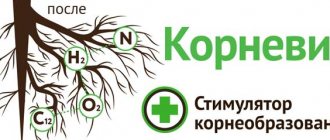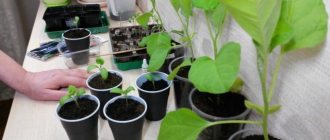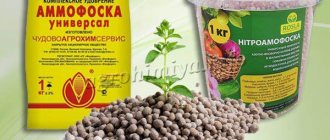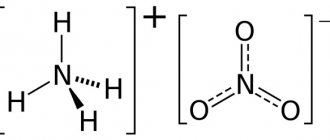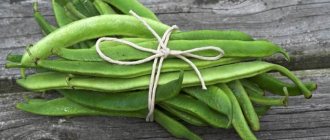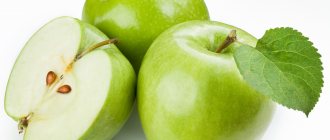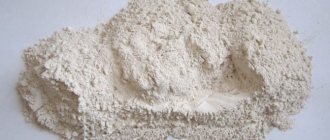What does it look like?
Tops
Purple carrots have spreading tops with characteristic needle-shaped leaves of a juicy green color. In appearance, the plant does not differ from the classic orange carrot .
Roots
The length of the vegetable can reach 20-30 cm. The outside of the root vegetable is painted bright purple, and inside it has an orange or yellow core. Also, the cut can also be painted purple, but of a slightly different shade, like beets. There are varieties that can have several colors on the cut - yellow, orange and purple (read about yellow varieties of carrots here).
May have anti-cancer properties
Research shows that the powerful antioxidants found in purple carrots have anti-cancer properties.
A 12-week study in which rats were exposed to a cancer-promoting substance found that rats fed purple carrot extract developed less cancer than those on a regular diet ().
Likewise, test-tube studies show that anthocyanins may inhibit the growth and spread of breast, liver, skin, blood, and colon cancer cells ().
A study of 923 people with colorectal cancer and 1,846 people without cancer found that women with a high intake of purple vegetables and fruits had a lower risk of developing colorectal cancer than women who ate fewer purple foods ().
Other studies show similar results among both men and women ().
Additionally, research shows that a diet high in all types of carrots may protect against breast cancer.
A review of ten studies that examined data from 141,187 women linked high consumption of all types of carrots to a 21% reduction in the risk of breast cancer ().
Moreover, diets high in vegetables in general, including carrots, have been associated with an overall reduction in cancer risk ().
Summary:
Eating purple carrots may reduce the risk of certain types of cancer, including colon and breast cancer.
Varieties
Purple carrots do not come in as many varieties as regular carrots, but several varieties are widely available for purchase.
Dragon
The root vegetables have a deep purple color and a yellow core . They reach 25 cm in length, have a sweet taste and a high content of vitamin A. Seeds can be purchased in specialized stores. The price for a bag of seeds varies between 100-150 rubles.
Purple Elixir
Root vegetables are easily distinguished from other varieties by their purple-violet color. In cross section, they are three-colored - an orange core, an intermediate yellow layer and a purple outer layer. Planting material is widely available for purchase at gardening stores. Cost – 120-150 rubles per bag.
Purple Haze
The fruits of this hybrid are dark purple on the outside and orange on the inside. The variety is early ripening and already 70 days after emergence it grows up to 30 cm in length. Resistant to diseases.
It is almost impossible to find planting material of this variety in markets, but it can easily be purchased via the Internet or in specialized stores.
The cost of a bag of seeds is 130-160 rubles.
Cosmic Purple
Early ripening variety. The vegetable has a purple color with a raspberry tint due to its thin, brightly colored skin. The inside of these carrots is a classic orange color. Very juicy and crispy fruits, 20 cm long. Planting material can be purchased at gardening stores online or offline. The price for a bag of seeds varies between 90-140 rubles.
Description of purple carrots
Purple carrots are attractive in appearance, but are valued for their rich chemical composition and beneficial properties.
Appearance and taste
Purple carrots belong to the Apiaceae family. The vegetable has green foliage with feathery leaves and a strong root shaped like an elongated and pointed cone. Its color comes in many shades of purple. Most varieties have an orange core. The size of the root crop is from 20 to 30 cm in length and 2-3 cm in diameter.
The taste is unusual, sweet, slightly spicy, with a pine aftertaste of rosemary. The pulp is juicy.
Origin and development
Until the 16th century, ordinary carrots were purple. The orange color we are used to is the result of the work of Dutch breeders. By growing purple carrots, we return to their original appearance.
Chemical composition, trace elements and vitamins, beneficial properties
Purple carrots contain many vitamins and minerals. 100 g of vegetable contains:
- potassium – 200 mg;
- vanadium – 99 mg;
- chlorine – 63 mg;
- phosphorus – 55 mg;
- magnesium – 38 mg;
- calcium – 27 mg;
- sodium – 21 mg;
- sulfur – 6 mg;
- copper – 80 mcg;
- fluorine – 55 mcg;
- molybdenum – 20 mcg;
- nickel – 6 mcg;
- lithium – 6 mcg.
Carrots contain vitamins A, B, C, E, and beta-carotene. It is also characterized by a high content of anthocyanins - plant pigments that cause the purple hue of the root vegetable. The body does not produce them on its own.
Thanks to the presence of these beneficial substances, regular consumption of purple vegetables contributes to:
- strengthening immunity;
- strengthening the cardiovascular and nervous systems;
- improving metabolism;
- normalization of blood pressure;
- strengthening vision;
- reducing blood sugar and cholesterol levels;
- improving the condition of hair, nails and skin.
Purple carrots are used in weight loss diets. It contains few calories and a lot of fiber, saturates well, improves digestion, and promotes the absorption of nutrients.
Features of application
In cooking, purple carrots are used in the same way as orange ones: stewed, fried, boiled, baked, steamed, added to soups, sauces, gravies, used in salads, juices and marinades. The plant is combined with different products - other vegetables, cereals, meat. The vegetable is often used to decorate dishes. Purple carrot food is tasty, healthy and easy to digest.
Ripening period
Purple carrot varieties are classified according to ripening time:
- early ones ripen 65-80 days after germination;
- mid-season - with a growing season of 100-110 days;
- late - the ripening period ranges from 120 to 140 days.
Productivity
High seed germination does not affect the yield of purple carrots. The harvest volume is lower compared to orange varieties.
Disease resistance
Purple carrots are highly resistant to diseases, but are susceptible to bacteriosis, phomosis, septoria, brown spot, black, red, gray and white rot.
To prevent the development of diseases, seeds and soil are disinfected before planting. The tops of adult plants are sprayed with fungicides.
Also dangerous to the vegetable are insect pests: slugs, cutworms, carrot flies and wireworms. Treating the soil with chemicals in the spring helps combat them.
Growing regions and climate requirements
Purple carrots are grown in all regions of Russia. Some varieties are not suitable for growing in southern regions with hot summers, because at elevated temperatures they slow down development.
Comfortable temperature for growth is +20…+23°C. When raised, shading is required. Most varieties are cold tolerant and can tolerate temperatures as low as -4°C.
Popular varieties and hybrids
Below are popular varieties and hybrids of purple carrots:
- Dragon. An early ripening variety with a growing season of 85-90 days. The outside of the root is bright purple, the inside is orange. Its length is up to 25 cm, diameter is within 3 cm. After heat treatment, carrots retain their spicy aroma and taste. Productivity – 5-7 kg per 1 sq. m. Dragon is adapted to cold climates and is unsuitable for long-term storage.
- Cosmic Purple. A variety with an early ripening period - 60 days. The outside of the root crop is raspberry-violet, but the inside is completely orange. Length – within 20 cm. Carrots taste sweet and crispy. Productivity – 5-8 kg per 1 sq. m. The variety is often used fresh, since during heat treatment it loses its beneficial qualities and attractive appearance.
- Purple haze. An early ripening variety, ripening 70 days after sowing. For winter storage, the crop is harvested after 100 days. The hybrid is characterized by a dark purple color on the outside and orange on the inside. The length of the root crop varies from 15 to 30 cm, diameter - up to 5 cm, average weight - 180 g. Productivity - 5 kg per 1 sq. m.
- Purple. The growing season is from 90 days. The length of the root crop is about 25 cm, diameter is 4-5 cm, weight is up to 180 g. It does not lose color during heat treatment. Productivity – up to 7 kg per 1 sq. m. Despite early ripening, Purple carrots are suitable for long-term storage.
- Purple dragon . The root is purple-red on the outside and orange-yellow on the inside. Fruit length – up to 25 cm, diameter – 3 cm. The variety is recommended for use as a seasoning. Also added to salads, when canning. Productivity – 4 kg per 1 sq. m.
- Queen purple. Hybrid with a late ripening period - 140 days. Vegetables begin to be eaten after 110 days. The outside is purple, the inside is orange. The length of the root crop is about 20 cm, diameter is 5 cm, weight is on average 200 g. Productivity is about 5.5 kg per 1 sq. m.
- Caramel purple. Late-ripening variety - the growing season lasts 140 days. The root vegetable with purple pulp and an orange core grows on average up to 17 cm, diameter - about 5 cm, weight - up to 200 g. Productivity - 5-6 kg per 1 sq. m. Purple Caramel carrots are suitable for winter storage.
- Chocolate bunny F1 . Early ripening hybrid. The growing season is 60 days after emergence. The outside of the root is grayish in color, the flesh is purple or burgundy, and the core is bright orange. The length of the fruit is up to 30 cm, the average weight is 180 g. Productivity is about 5 kg per 1 sq. m. Carrots Chocolate hare are recommended to be consumed fresh.
Chemical composition of root vegetables
According to research, the chemical composition of purple carrots is much richer than that of regular orange ones. It contains perfectly balanced vitamins and minerals. The root vegetable is rich in beta and alpha carotene, and its unusual color is due to the presence of anthocyanin in the substance. Vitamins included in the composition: B3, B1, B2, B5, B6, B9, C, E, H, K, PP.
Minerals:
- calcium;
- magnesium;
- sodium;
- potassium;
- phosphorus;
- chlorine;
- sulfur;
- iron;
- zinc;
- iodine;
- copper;
- manganese;
- selenium;
- chromium;
- fluorine;
- molybdenum;
- boron;
- vanadium;
- cobalt;
- lithium;
- aluminum;
- nickel.
The White Carrot Mystery and Classification Issues
In ancient Rome and Greece, carrots were called differently, leading to conflicting interpretations. In particular, the name Pastinaca could hide almost white carrots and the light root vegetables of the extremely popular parsnip at that time.
Galen suggested giving the carrot the name Daucus, separating it from related species. This happened in the second century of the new era. In those same years, the Roman scientist Athenaeus proposed the name Carota, and the root vegetable is also named in the cookbook of Apicius Czclius, dating back to 230.
However, with the fall of Rome, mentions of carrots completely disappear from European written sources. And confusion in identifying plants that were close in species and relatedness continued until the Middle Ages, until purple and yellow root crops were again brought to Europe from Asia.
Charlemagne issued a decree on the full reverence of carrots and recognition of them as the most valuable plant, and thanks to their openwork leaves and umbrella inflorescences, carrots became known in history as “Queen Anne’s lace.”
Today, the names of all varieties, from white root vegetables to black carrots, are subject to the classification Linnaeus developed in 1753.
Benefits and harms
- Purple carrots are the richest source of vitamin A. Eating the root vegetable helps relieve fatigue, improves vision and alleviates some ophthalmic diseases, such as cataracts.
- The vegetable also slows down the aging process in the body, strengthens the immune system and, in complex therapy, helps to recover from heart and vascular diseases.
- The anthocyanin contained in the composition is effective in preventing cancer.
Purple carrots can cause harm in case of individual intolerance or abuse.
It is recommended to limit the consumption of this vegetable to people suffering from stomach ulcers or inflammation of the small intestine.
History of carrots in ancient times
Archaeologically verified evidence of the consumption of wild carrots has been found at early human sites in Switzerland.
Temple paintings in Luxor, Egypt, dating back to the second millennium BC, depict purple root vegetables. And papyri found in one of the pharaoh’s burials speak of treatment with carrot seeds or a plant similar to it. But neither archaeologists nor paleobotanists have yet been able to confirm Egyptologists’ assumptions about the distribution of purple carrots in the Nile Valley. The ancient Egyptians may have been familiar with other members of the Apiaceae family, such as anise, celery or coriander.
Fossilized carrot seeds, at least five thousand years old, have been discovered in the highlands of Iran and Afghanistan.
Many varieties in a variety of colors have been found in Asia, and there is evidence of the use of wild carrots during the Hellenic period in Greece. Carrot seeds and their rhizomes were mainly used for medicinal purposes. For example, in the Ardennes during ancient Rome, carrots served as an aphrodisiac, and the Pontic king Mithridates VI believed that carrots could neutralize poisons.
Dioscorides, who served as a doctor in the Roman army, described and sketched more than 600 species of medicinal plants during his campaigns in his work De Materia Medica. The Byzantine edition of the work, dating back to 512, shows the reader the appearance of an orange carrot.
Step-by-step instructions: how to grow?
Purple carrots have fairly simple agricultural technology, and the features of caring for them are similar to those used for orange carrots .
Preparing for landing
- Inventory . To organize the garden bed you will need a shovel and a rake. The grooves can be made using a special small flower spatula. You will also need a watering can with a nozzle with small holes.
- Soils . The best predecessors for carrots are potatoes, onions, and cucumbers. The soil must be fertile and well fertilized.
- Semyon . Before planting, the seeds must be soaked for a day - this will speed up their germination and help identify non-viable seed.
Planting process
- Landing dates . Carrot seeds are sown in the ground in early spring. Purple varieties have good germination.
- Planting scheme . The seeds are distributed in the garden bed in rows with an interval of 1-2 cm. 15-20 cm should be left between the rows.
Care
- Suitable microclimate . Carrot plantings do well at temperatures of +23+26 and are quite unpretentious in matters of humidity. The main thing is to follow the watering regime. If the weather is hot, carrot tops can be sprayed.
- Watering . Carrot plantings should be watered with warm, settled water in the evening. Moisture should be completely absorbed into the ground without the formation of puddles and stagnation.
- Feeding . Carrots are fed at least twice during the season. The first feeding is carried out in the phase of 3-4 leaves with ammonium nitrate. The second - after the final thinning, using superphosphate fertilizers.
- Loosening . After the carrot seedlings have become stronger, it is necessary to regularly loosen the soil. This will help avoid the formation of a crust on the ground.
- Weeding . The first thinning is carried out after the appearance of 1-2 true leaves. Large seedlings should be left at a distance of at least 2 cm from each other.
- Mulching . You can mulch purple carrots with chopped straw; this will perfectly retain moisture and eliminate the need to loosen the soil.
Harvesting and storage
Purple carrots have lower yields than orange varieties.
- If an early ripening variety was planted, the harvest can be harvested in mid-summer.
- Medium-ripening varieties are harvested 80-110 days after emergence.
- Late-ripening purple carrots are harvested in the fall, in the first two weeks of September in dry weather.
The differences between varieties based on ripening time are described here.
The harvest should be stored in a cool, well-ventilated, dry room, where rodents and harmful insects do not have access.
The purple root vegetable is not a frequent guest on tables. In our articles you can read about other varieties of carrots: Dutch, black, white, as well as Children's Sweetness and Flakke.
Mirzoi Yellow
The variety is mid-season, very productive, and easily adapts to various growing conditions.
The roots are spindle-shaped, aligned, with a sharp tip, up to 25 cm long, up to 3-4 cm in diameter, with a smooth shiny surface of canary yellow color and a core of the same color.
The pulp is crispy, sweet, soft taste. The fruits do not lose their taste and bright color after heat treatment. The storage period is long.
“Old”, a well-proven variety of Uzbek selection, early ripening, productive.
Root vegetables are cylindrical in shape, leveled, with a blunt rounded tip, up to 15 cm long, up to 3 cm in diameter, with a smooth shiny surface of bright yellow and light yellow color and the same core.
The pulp is crispy, medium-sweet taste, juicy. The fruits do not lose their taste and bright color after heat treatment. The storage period is long.
List of mistakes and how to avoid them
- Thickening of plantings . Purple carrots have good germination, so do not sow the garden bed with seeds. Emerging seedlings must be thinned out in a timely manner.
- Uneven watering . Failure of the irrigation regime leads to deformation and cracking of the fruit, so you should strictly adhere to the recommended scheme.
- Adding fresh organic matter . You cannot fertilize carrots with fresh manure. Excess nitrogen harms the plant.
- Planting seeds in heavy soil with high acidity . The soil for planting carrots must be carefully prepared, balancing all the indicators.
Harvest and storage
The cellar is ideal for long-term storage of root vegetables
When harvesting ripe carrots, you will need a fork or bayonet shovel. With their help, you need to carefully dig up the root crops without damaging them. It is not worth harvesting the ripe crop manually, as it is quite difficult.
After harvesting, carrots must be carefully sorted and spoiled vegetables should be thrown away. Then the fruits are dried and placed in a cellar for further storage.
Many people do not know that carrots were originally purple and consider varieties with this color to be something unusual. Gardeners who want to plant carrots with purple fruits must first understand the peculiarities of growing them at home.
Diseases and pests and their prevention
Purple carrots are highly resistant to diseases and pest attacks , so when growing any of its varieties, prevention is quite effective.
- Fomoz . The disease affects root crops; they become covered with black-brown spots with a white coating. Fertilizing with nitrogen helps prevent disease.
- White rot . Fruits affected by this disease become soft and covered with a white coating. The disease is treated by applying potassium supplements.
- Carrot fly . It damages root crops and the tops acquire a bronze tint. Timely removal of weeds will help prevent the pest from attacking, and to get rid of the insect, carrots are treated with insecticidal preparations.
Prevention
The main preventive measures are proper care and timely initiation of treatment when any diseases or pests are detected. Not every disease can be treated; prevention is a must.
To prevent Phoma, phosphorus and potassium fertilizers are applied and the tops are removed in a timely manner.
Prevention of bacteriosis includes soaking seeds before planting in the soil and spraying with hom.
To avoid cercospora blight, soak the seeds in hot water and spray the young shoots with Bordeaux solution.
You can avoid the appearance of brown spot if you regularly apply loosening between the rows, especially during rains. Treatments with solutions of horsetail, celandine, and nettle help.
Meet Purple Carrots – 7 DachasTrying Purple Carrots
